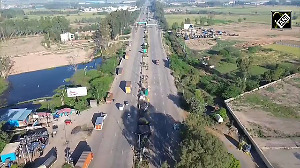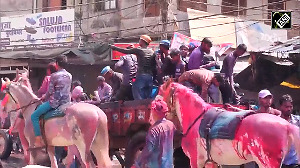In 1990 and 1991, when the fire started by the Mandal Committee report engulfed northern India, the southern states were strangely silent.
Today, when Human Resource Development Minister Arjun Singh's Mandal II is seeing passionate protests in many parts of the country, Tamil Nadu is once again silent.
Why? Because about 80 per cent of the state's population is already under the reservation umbrella.
In 1980, much before the V P Singh government's Mandal move, the Tamil Nadu government had implemented 69 per cent reservation for backward classes in educational institutions and jobs.
A brief history of quotas in Tamil Nadu
P Radhakrishnan, professor of sociology, Madras Institute of Development Studies, says it was the non-Brahmin movement in Madras Presidency (as the province was called during British rule) during the 1910s and 1920s -- and the movement launched by the Backward Classes from the 1930s to the 1950s -- that gave a new caste idiom to South Indian politics and the policies about the Backward Classes, or BCs.
"It was mainly against the background and knowledge of these movements, and pressures for reservation for the backward classes that the Constituent Assembly adopted Article 10(4) (now Article 16 (4)) providing for job reservation," says Professor Radhakrishnan.
In 1969, the Dravida Munnetra Kazagham government under M Karunanidhi appointed the first Tamil Nadu State Backward Classes Commission with A N Sattanathan as the chairman. The Commission found that the Most Backward Classes -- or MBCs -- in Tamil Nadu had a very small presence in state services and professional colleges as they were clubbed together with other castes.
From 1951 onwards, reservation for the Backward Classes was 25 per cent but the Sattanathan Commission recommended a separate educational and employment reservation of 16 per cent for the Most Backward Classes and 17 per cent for the Backward Classes.
In 1971, the DMK government hiked the reservation for the Backward Classes from 25 per cent to 31 per cent and for the Scheduled Castes and Scheduled Tribes from 16 per cent to 18 per cent.
In 1980, MGR's All India Anna Dravida Munnetra Kazagham government increased the reservation for the Backward Classes from 31 per cent to 50 per cent.
From then on, there has been 69 per cent reservation in educational institutions.
The second Tamil Nadu State Backward Classes Commission came into existence on March 15, 1993, at the Supreme Court's instance. It was formed to examine and recommend upon the requests relating to inclusion and exclusion from the list of Backward Classes and Most Backward Classes.
The Commission conducts enquiries on the representations received from various community organisations and individuals for inclusion of their communities in the list of Backward Classes.
The Commission looks into three factors while identifying a caste group as backward -- social backwardness, economic backwardness and educational backwardness. The weightage allotted is 50 per cent for social backwardness, 40 per cent for educational backwardness and 10 per cent for economic backwardness.
The report card
In the Common Entrance Test conducted by Anna University for admission to engineering and medical studies, the cut-off marks for general students and OBC students are almost the same.
Does that mean reservation has started achieving its purpose?
"Yes," says Professor P S Balasubramanian, former head of the Department of Education, Madras University. "It is only because of the reservation policy followed by the state for the last several years that the OBCs have reached this level. There is no second opinion about it. Education is the means of social mobility, and reservation has helped those in the deprived sections of society to have vertical mobility in the social strata," he adds.
Professor Radhakrishnan disagrees. He says there is no connection between reservation and admissions, particularly in the context of Tamil Nadu, because almost every group is included in the 69 per cent category, except a few upper castes.
"At least 80 per cent of the population is included in the reservation net. If you look at the data of the last five years, you will see that it is only the creamy layer of the Other Backward Classes that gets all the benefits," says Professor Radhakrishnan.
"If you look at the employment data, the MBCs, the SCs and the STs have not benefited. The real needy will benefit only when we remove the creamy layer. For the last 56 years, reservation has not reached the needy, and there is data to show that," he insists.
At least 35 per cent of India's population the age group between 20 and 25 aspires for higher education, but the present enrolment in higher education -- beyond the higher secondary level -- is only 9 per cent to11 per cent, as against 45 per cent to 85 per cent in developed countries.
D Sundaram, retired professor of sociology, Madras University, who was also a member of the second Tamil Nadu State Backward Classes Commission from 1993 to 2001, looks at 69 per cent reservation as a necessity. He admits that in Tamil Nadu, more than 200 caste groups -- 246, to be precise -- are considered backward.
Recently two Brahmin communities have urged the Commission that they be included in the Backward Classes list, but the Commission has not obliged.
"Eligibility to backwardness is not based on economic and educational backwardness alone. It is not a poverty alleviation program. So, a community that is socially forward will not be included," says Professor Sundaram.
Digging into the creamy layer
The report of the Sattanathan Commission submitted in 1970 said, 'some castes have taken full advantage of the state's protective measures and made rapid strides, while many others continue to trail behind and are still in the lower stages of stagnancy.'
Therefore, the Commission recommended the removal of the 'creamy layer' from the list of beneficiaries -- exclusion of those families of salaried persons whose annual income exceeded Rs 9,000, landowners with more than 10 acres of land and business people with taxable income exceeding Rs 9,000.
The then DMK government did not attempt to eliminate the creamy layer, says Professor Radhakrishnan. Nor did it offer separate reservation for Most Backward Classes.
The AIADMK ministry headed by M G Ramachandran issued a Government Order in July 1979 prescribing an annual income lower than Rs 9,000 for Backward Classes as eligibility to get the benefits of reservation.
When his party was defeated in the 1980 Lok Sabha election, MGR not only withdrew the order but increased the reservation for the BCs from 31 per cent to 50 per cent.
When the total reservation exceeded 50 per cent, the Supreme Court on October 15, 1982, directed the state government to constitute the second Tamil Nadu Backward Classes Commission.
Under the chairmanship of J A Ambasankar, it started reviewing the existing list of Backward Classes in the reservation bracket. The Commission also found that of the total number of Backward Classes students admitted to professional courses, more than three fourths were from a small number of Backward Classes -- 34 out of 222 then -- accounting for only about two fifths of the Backward Classes population in the state.
Professor Sundaram says the second Tamil Nadu Backward Classes Commission had identified who form the creamy layer in each caste group, and had recommended that they be removed from the list of beneficiaries.
"You just cannot remove the entire caste group from the list; only individuals can be deleted but the state has its own methodology in implementation. If a person has availed the benefits, his son or daughter cannot be excluded from the list. It will take at least three generations for the family to come up," he says.
The Commission recommended that economics and occupation should be identified as two criteria with which the creamy layer can be identified.
"It is not the Commission that is lagging behind in making recommendations; the state government is also not lagging behind in accepting the recommendations on the creamy layer concept. There are some problems in implementation because it has to be decided at the individual level," says Professor Sundaram.
"There has to be a proper methodology to ascertain that. Creamy layer is based on the principle of lower eligibility. Those who have availed the provisions should opt out. No community is against removing benefits for the creamy layer. Unless a layer moves out, the rest cannot avail the opportunities," he adds.
Professor Radhakrishnan observes that no state has so far implemented the SC directive to remove the creamy layer from the OBCs.
But Professor Balasubramanian is of the opinion that in 10 or 15 years, nobody can come to a conclusion that a family has benefited from reservation.
"It needs a longer period. For generations they were deprived and only now they are coming up. It will take generations for them to get the full benefits of reservation," he says.
The way out
The big question is how to ensure the benefits of reservation reach the real needy.
Like the United Nations Educational, Scientific and Cultural Organisation has been advocating from 1946, Professor Radhakrishnan also sees universal education at the primary level -- by giving scholarships, etc -- as the only solution.
"I have sat on a number of interview boards. Students are motivated but the problem is language, particularly for students coming from villages. The medium of education is important in this globalised world as higher education is in English. We have to address the basics first," he says.
Professor Sundaram feels the only solution to the problem is to increase in the number of educational institutions and seats.
"We have to take into consideration that our population has increased tremendously. If a person in the open category and (a person in the)reserved category get 98 per cent, it shows given an opportunity, even those from the Backward Classes can come up. But his reservation shouldn't be at the cost of somebody else who is also equally good," he insists.
Professor Balasubramanian quotes Jayaprakash Narayan: "Like JP said, we should think of vocationalising education. By this, he meant, after providing basic education, recruit them in various professions and then absorb them. The responsibility of training them should be by those who appoint them because then, the training will be job-relevant and not job-oriented. Let this be done by industries also," he says.
The high temples of learning
Not all are in favour of increasing the number of seats in institutions like the Indian Institutes of technology.
Professor Balasubramanian says IITs are not mere engineering colleges, but meant to be research-oriented institutions. "You can increase the seats in other institutions but as IITs are meant as research institutions, the idea of increasing the number of seats is not good. You need committed people for research," he points out.
"All the students can, but all the students do not. Why are they not doing what they can? Because of lack of opportunities. We have to start at the primary level first," he insists.
Post script
Professor Radhakrishnan points out that Article 15 of the Constitution prohibits discrimination by the State by any means. Clause 4 to the Article was introduced in 1950 which empowers the State to provide special powers for the advancement of the socially and educationally backward classes.
"There is no reference to educational reservation in the Constitution but there is a clear reference to job reservation. Nobody has challenged it in court so far but it can happen. Private institutions can challenge this in court," Professor Radhakrishnan says.
"The Venkatachelliah Committee report on the review of the Constitution also talks about only job reservation in relation to Article 46," he adds.
Also see
Complete Coverage: The Reservation Issue







 © 2025
© 2025